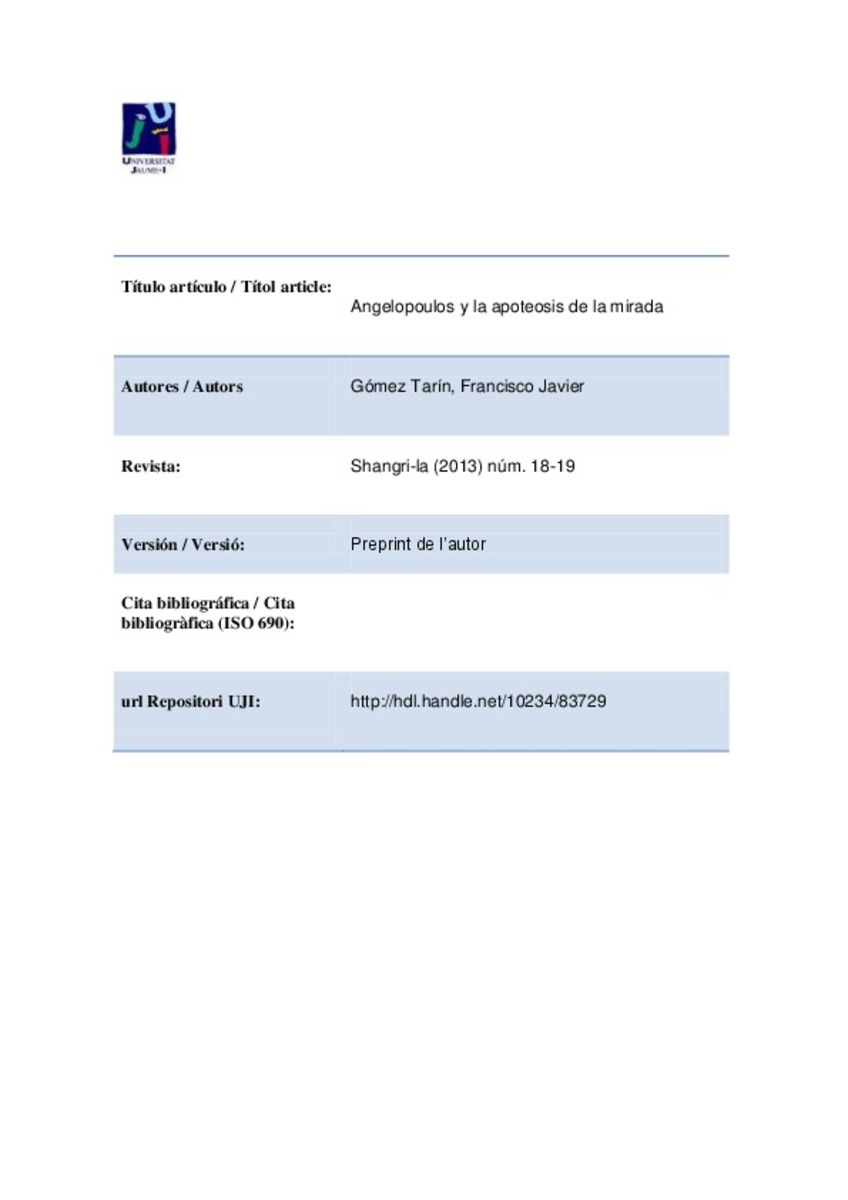Mostrar el registro sencillo del ítem
Angelopoulus y la apoteosis de la mirada
| dc.contributor.author | Gómez-Tarín, Francisco Javier | |
| dc.date.accessioned | 2014-02-18T07:54:42Z | |
| dc.date.available | 2014-02-18T07:54:42Z | |
| dc.date.issued | 2013 | |
| dc.identifier.issn | 2172-0363 | |
| dc.identifier.uri | http://hdl.handle.net/10234/83729 | |
| dc.description.abstract | La desaparición de Theo Angelopoulos (“ou” impuesto por la pronunciación francesa) puede considerarse sin género de duda como una gran pérdida para el cine contemporáneo, sobre todo desde la perspectiva del europeo que con él pierde un referente de la capacidad que poseen los discursos ficcionales para reflexionar sobre la historia. Esta veta mayúscula de su obra impide en ocasiones la mirada reposada sobre los aspectos directamente vinculados al discurso fílmico, a su formalización; camino este que no deberíamos dejar de lado, toda vez que su cine supone una importante aportación a las formas narrativas y al trabajo enunciativo inscrito en los significantes. Es por ello que, a sabiendas de los textos que otros colegas escriben aquí mismo sobre los aspectos relativos a los contenidos, quisiera intentar acercarme a algunos de los estilemas de su cine, sobre todo a aquellos que tienen que ver con la utilización del plano-secuencia y las relaciones entre campo y fuera de campo: no es la primera vez que lo hago y gran parte de las reflexiones vienen traídas aquí desde textos previos aunque convenientemente reordenados (Gómez Tarín, 2004, 2005, 2006, 2010), incluso debiendo a mi pesar constatar cómo estos paradigmas de su cine se han ido constituyendo paulatinamente en “modos constantes” y han perdido con el tiempo gran parte de su fuerza inicial. | ca_CA |
| dc.description.abstract | The demise of Theo Angelopoulus (the “ou” being imposed by the French pronunciation) can without a shadow of a doubt be considered a great loss for contemporary cinema, above all from the European perspective, which has lost a reference as regards the capacity of fictional discourses to reflect upon history. This substantial streak running through his works sometimes makes it impossible for the eye to take a calm look at the aspects directly linked to cinematographic discourse, and to its formalisation, which is a path we should not stray far from since his films are an important contribution to narrative forms and expository work involving significants. This is why, fully aware of the texts that other colleagues write here on the aspects related to the contents, I would like to attempt to get closer to some of the stylistic dictates of his films, above all those that have to do with the use of shot-sequence and the relations between being inside and outside the field of action: it is not the first time I have undertaken such a study and many of the reflections set out here have been taken from previous texts, although rearranged in a suitable fashion to fit the present requirements (Gómez Tarín, 2004, 2005, 2006, 2010). I even have to unwillingly confirm how these paradigms of his films have gradually become “constant modes” and with the passing of time have lost much of their initial force. | |
| dc.format.extent | 28 p. | ca_CA |
| dc.format.mimetype | application/pdf | ca_CA |
| dc.language.iso | spa | ca_CA |
| dc.publisher | Shangri-la Ediciones | ca_CA |
| dc.relation.isPartOf | Shangri-la (2013) núm. 18-19 | ca_CA |
| dc.rights | © Shangri-la Ediciones | |
| dc.rights.uri | http://rightsstatements.org/vocab/InC/1.0/ | * |
| dc.subject | Theo Angelopoulos | ca_CA |
| dc.subject.other | Angelopoulos, Thodōros, 1935- -- Crítica i interpretació | ca_CA |
| dc.title | Angelopoulus y la apoteosis de la mirada | ca_CA |
| dc.type | info:eu-repo/semantics/article | ca_CA |
| dc.rights.accessRights | info:eu-repo/semantics/openAccess | ca_CA |
Ficheros en el ítem
Este ítem aparece en la(s) siguiente(s) colección(ones)
-
COM_Articles [810]







